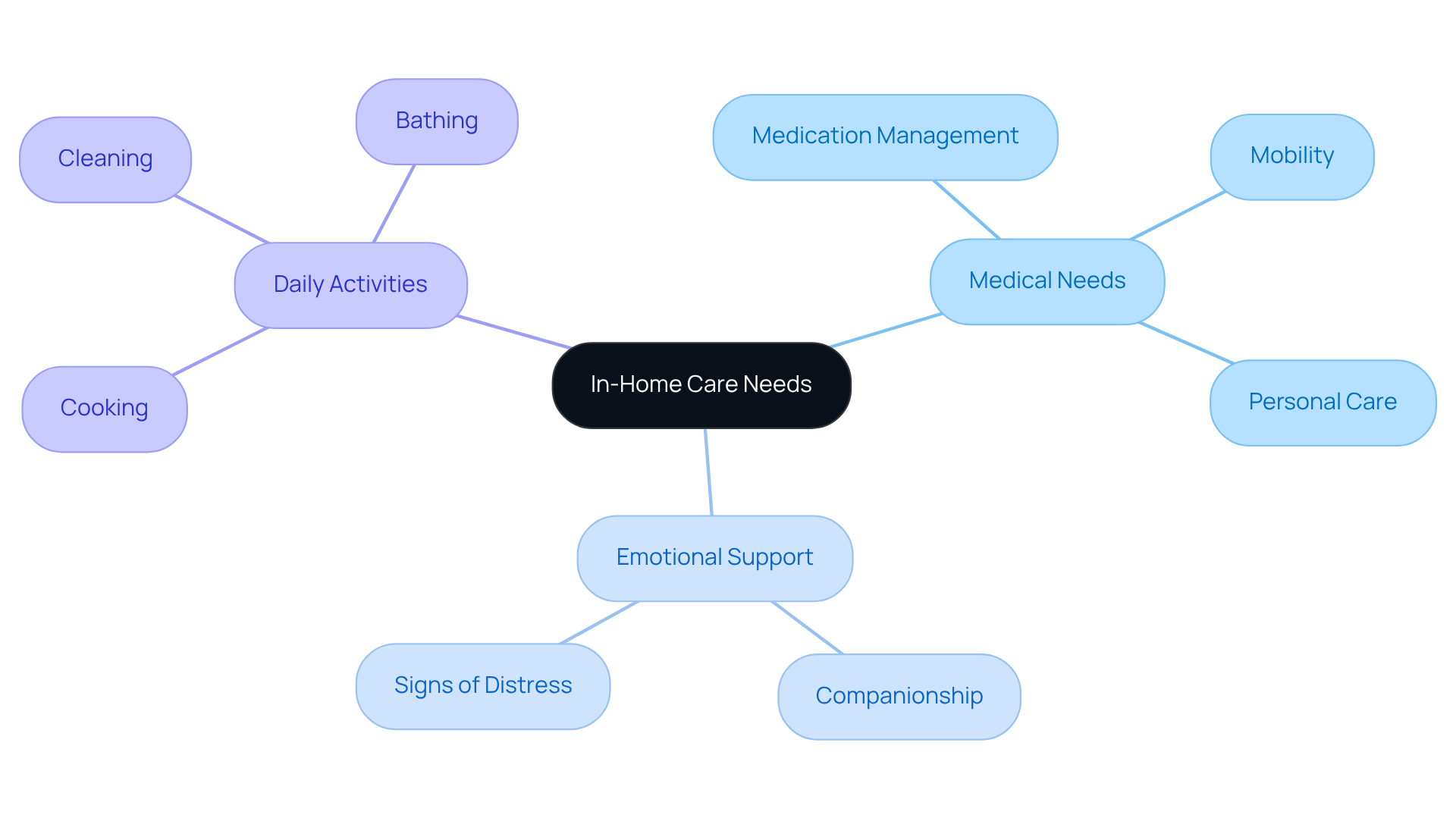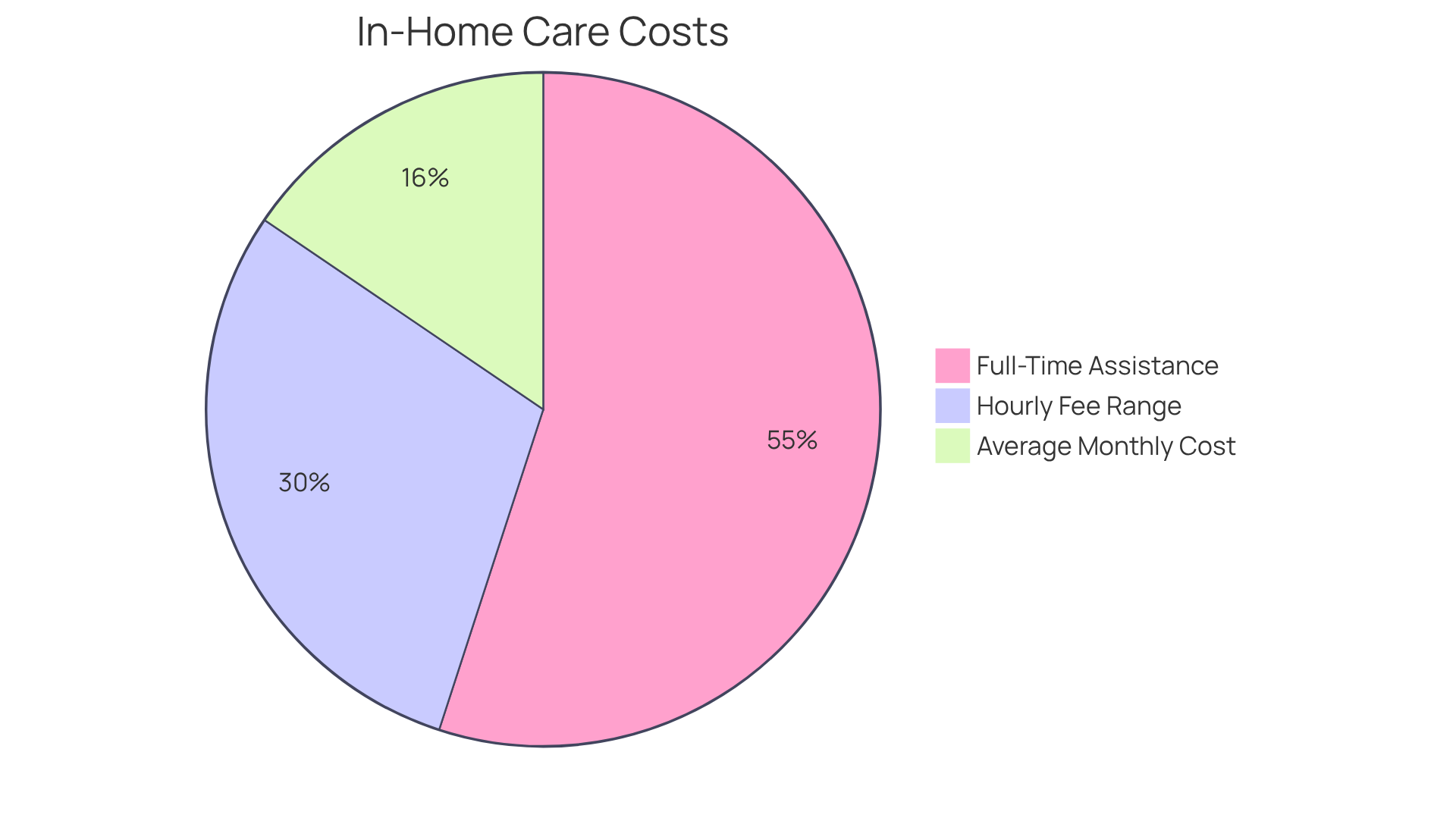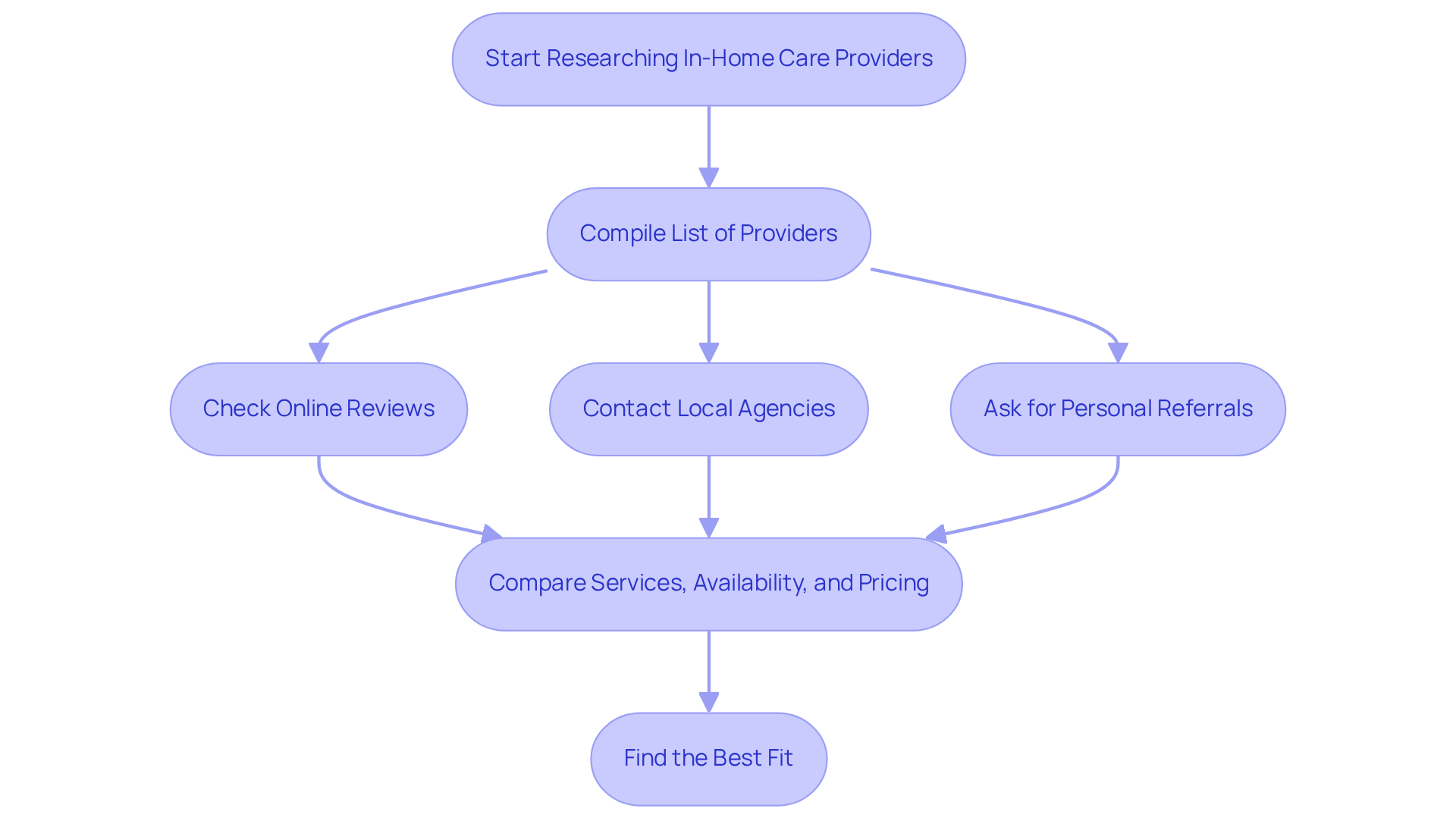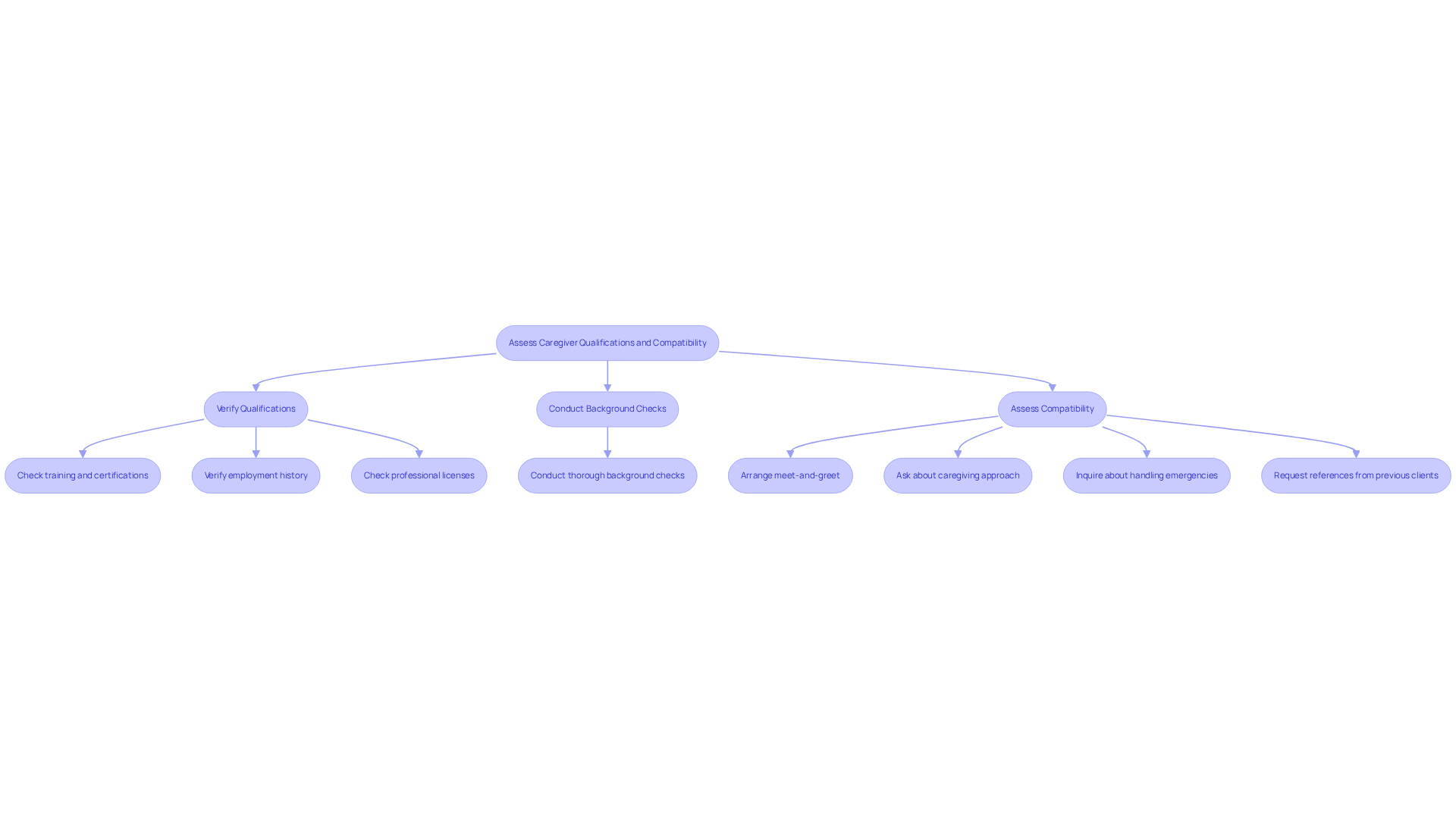Introduction
Navigating the complexities of in-home care can feel overwhelming for families in Thousand Oaks, CA, especially when a loved one’s well-being is on the line. It’s essential to understand the specific needs of seniors—whether it’s medical assistance or emotional support—because this knowledge is key to ensuring they receive the right care. Yet, with varying costs, provider options, and caregiver qualifications, how can families make informed choices that balance quality care with financial realities?
This guide aims to outline essential steps to simplify the process, empowering families to discover in-home care solutions that are tailored to their unique circumstances. Remember, you’re not alone in this journey; there are compassionate resources available to help you every step of the way.
Understand Your In-Home Care Needs
Start by carefully evaluating the specific needs of your loved one, focusing on a few key areas:
- Medical Needs: Consider whether they need help with medication management, mobility, or personal care tasks. Many seniors may require assistance with daily medications, which can greatly affect their health outcomes.
- Emotional Support: Think about the importance of companionship. Emotional well-being is vital; studies show that prolonged social isolation can be as harmful to health as smoking or obesity. It’s crucial to understand if your loved one feels lonely or isolated. Caregivers are trained to spot signs of emotional distress in seniors, helping to provide timely support.
- Daily Activities: Identify which daily tasks are challenging, like cooking, cleaning, or bathing. Caregivers can ease these burdens, promoting independence and allowing seniors to engage in activities that bring them joy and a sense of purpose.
Engage in open conversations with your loved one to gain insights into their preferences and concerns. This dialogue not only builds trust but also helps tailor support to their unique needs. Documenting these requirements is essential to create a clear picture of the necessary support services, ensuring that both medical and emotional assistance are adequately addressed.
Evaluate the Costs of In-Home Care Services
Assessing the expenses of in-home care in Thousand Oaks, CA, is crucial for families seeking support for their loved ones. Caregiver fees in this area typically range from $24.83 to $34.13 per hour, reflecting the level of assistance required. It’s important to note that the average starting cost of a caregiver in Thousand Oaks is about 4% higher than the California average starting rate of $23.79 per hour. For those considering full-time assistance, monthly costs can vary from $5,030 to $7,000. Meanwhile, the average monthly expense for home support is roughly $3,228 for 130 hours of work, providing a clearer picture of the financial commitment involved.
When planning for these costs, exploring potential financial assistance options is essential. Programs like Medicare and Medi-Cal may cover specific in-home assistance services, helping to alleviate some of the financial strain. Additionally, families should consider creating a comprehensive budget that includes out-of-pocket expenses, such as private payment options and any relevant insurance benefits.
Financial advisors often recommend a proactive approach to budgeting for in-home assistance. This involves evaluating the total expected costs and identifying any gaps that may need additional funding sources. By understanding the financial landscape and available resources, families can make informed decisions that ensure their loved ones receive the necessary support while maintaining financial stability.
Research Available In-Home Care Providers
Starting your research for in-home care in Thousand Oaks, CA can feel overwhelming, especially when you’re looking for providers. It’s important to know you’re not alone in this journey. Many families have walked this path, and there are resources available to help you find the right support.
Begin by compiling a list of potential care providers. Online reviews can be incredibly helpful; websites like Yelp and Google Reviews offer insights into the experiences of other families. Reading about their journeys can provide comfort and guidance.
Don’t hesitate to reach out to local agencies, such as:
- Happy to Help Caregiving
- Comfort Keepers
- Homewatch CareGivers
They can share information about their services and availability, helping you understand what options are out there.
Additionally, personal referrals can be invaluable. Ask friends, family, or healthcare professionals for recommendations based on their experiences. Hearing about someone else’s positive journey can ease your concerns and provide reassurance.
Once you have your list, take the time to compare services, availability, and pricing. This process can help you narrow down your options and find the best fit for your needs. Remember, it’s okay to take your time; finding the right care is a significant step, and you deserve to feel confident in your choice.
Assess Caregiver Qualifications and Compatibility
When you’re looking for the right caregiver for your loved one, it’s important to approach the process with care and understanding. Here are some key points to consider:
- Qualifications: Take the time to verify their training, certifications, and experience in providing the specific type of care your loved one needs. This ensures they have the right skills to support your family member.
- Background Checks: It’s crucial that the agency conducts thorough background checks on their caregivers. This step helps you feel secure in your choice.
- Compatibility: Assessing personality traits and communication styles is vital. Consider arranging a meet-and-greet to observe how the caregiver interacts with your family member. This can provide valuable insights into their potential relationship.
Asking the right questions can also make a difference:
- What is your approach to caregiving?
- How do you handle emergencies?
- Can you provide references from previous clients?
This thoughtful process not only helps ensure that the caregiver is qualified but also that they are a suitable match for your family member. Remember, finding the right caregiver is about more than just qualifications; it’s about creating a connection that fosters trust and comfort.
Establish Communication and Support Systems
Creating a supportive caregiving environment starts with clear communication. Regular check-ins are vital. Schedule weekly or bi-weekly meetings with the caregiver to discuss your loved one’s progress and any concerns. This practice not only keeps everyone informed but also strengthens the bond between caregivers and families.
Encouraging relatives to participate actively in discussions and decisions about support is equally important. Studies show that when family members are involved, the quality of assistance improves significantly. With family caregiving increasing by 45% since 2015, it’s essential to recognize the growing need for robust support systems.
Documentation plays a crucial role, too. Use logs or online platforms provided by caregiving agencies to track support activities and monitor changes in health status. This meticulous documentation can be invaluable for ongoing assessments and adjustments to care plans.
Consider establishing a support network that includes healthcare professionals, family members, and friends. Such a network can offer both emotional and practical support, easing the burdens on caregivers and enhancing your loved one’s overall well-being. As Jason Resendez, President and CEO of the National Alliance for Caregiving, puts it, “This is an issue that continues to build strength and visibility, and this report helps to put numbers behind the urgency for that continuing, and for translating that into solid action.”
With nearly 63 million Americans providing care, the importance of a robust support system cannot be overstated; it plays a crucial role in managing the complexities of caregiving.
Conclusion
Navigating in-home care in Thousand Oaks, CA, can feel overwhelming. It’s essential to approach this journey with thoughtfulness and care, ensuring that your loved ones receive the support they truly need. By understanding their unique requirements, evaluating costs, researching providers, and assessing caregiver qualifications, families can create a nurturing environment that prioritizes both medical and emotional well-being.
It’s crucial to thoroughly assess the specific needs of your loved one. This includes not just medical assistance but also emotional support and help with daily activities. Financial considerations are significant too; understanding the costs associated with in-home care can empower families to make informed decisions while exploring potential financial assistance options. Researching and comparing available care providers, along with evaluating caregiver qualifications and compatibility, is vital to finding the right fit.
Securing in-home care is about more than just meeting physical needs; it’s about fostering relationships and ensuring emotional support. Families are encouraged to actively engage in the caregiving process, maintain clear communication, and build robust support systems that include healthcare professionals and loved ones. Embracing this comprehensive approach will not only enhance the quality of care but also contribute to a more fulfilling and dignified life for those receiving assistance.
Remember, you’re not alone in this journey. Many families have walked this path and found strength in community and support. By prioritizing both the emotional and practical aspects of care, you can create a loving environment that truly makes a difference.
Frequently Asked Questions
What should I consider when assessing in-home care needs for my loved one?
Start by evaluating their medical needs, emotional support requirements, and daily activities. Consider if they need help with medication management, mobility, personal care, companionship, and assistance with tasks like cooking, cleaning, or bathing.
Why is emotional support important for seniors receiving in-home care?
Emotional well-being is crucial as prolonged social isolation can be as harmful to health as smoking or obesity. Caregivers are trained to recognize signs of emotional distress, providing necessary support to combat feelings of loneliness or isolation.
How can I engage my loved one in discussions about their care needs?
Engage in open conversations to gain insights into their preferences and concerns. This dialogue helps build trust and allows you to tailor support to their unique needs.
What are the typical costs of in-home care services in Thousand Oaks, CA?
Caregiver fees in Thousand Oaks generally range from $24.83 to $34.13 per hour, with an average starting cost about 4% higher than the California average of $23.79 per hour. Monthly costs for full-time assistance can vary from $5,030 to $7,000.
What is the average monthly expense for home support in Thousand Oaks?
The average monthly expense for home support is roughly $3,228 for 130 hours of work.
Are there financial assistance options available for in-home care services?
Yes, programs like Medicare and Medi-Cal may cover specific in-home assistance services, helping to alleviate financial strain. Families should also create a budget that includes out-of-pocket expenses and insurance benefits.
What budgeting strategies should families consider for in-home care?
Families should evaluate total expected costs, identify any gaps needing additional funding sources, and consider a proactive approach to budgeting for in-home assistance to ensure financial stability while providing necessary support.






